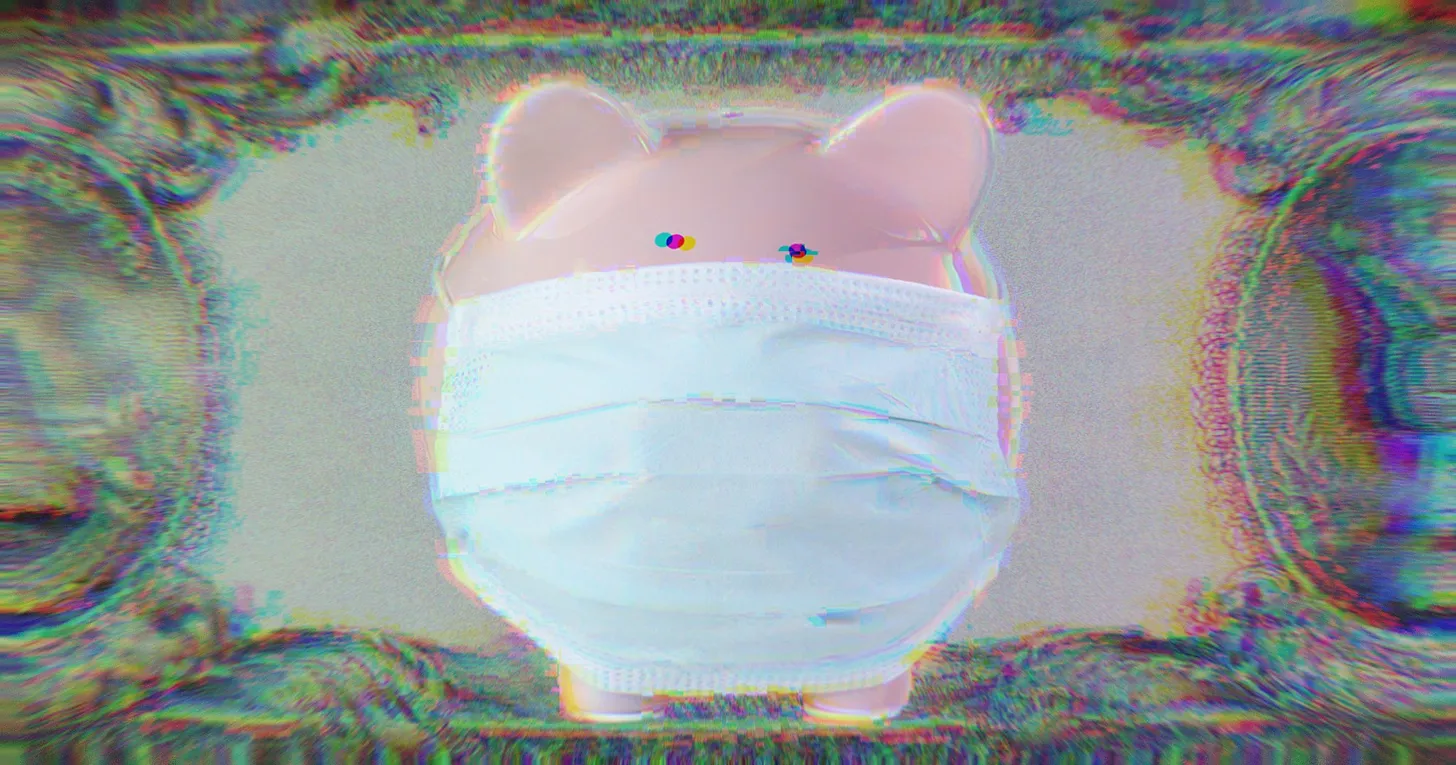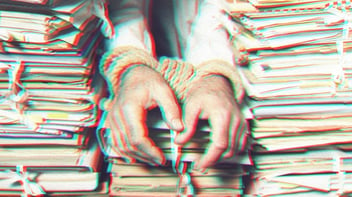Contagion!
When Banks Fail.
 Image Description: A piggy bank wearing a mask; bank contagion concept.
Image Description: A piggy bank wearing a mask; bank contagion concept.
Chapter One: All for one, one for all.
It may not feel like it, but you, me, everyone participating in the economy is part of the banking system. We are 100% correlated. To begin wrapping our heads around the unfolding crisis in the financial sector is to understand the mechanics of banking in a very basic way. Your assets are a bank’s liability. And vice versa.
If you have cash sitting in the bank, it’s a liability to them. Because it’s yours, not theirs.
The debt you have with them—your mortgage, auto loan, personal loan, credit card balances—these are their assets. Pretty simple.
Now, think about the structure of this exchange in money and the cost of doing business:
-
You have a free checking account. The bank has people to manage accounts. So that’s a cost to them.
-
You have a savings account. A bigger cost, because they have to pay you interest on that.
-
Maybe you have a higher interest account like a CD. An even bigger cost because they still have people looking after this, reporting requirements, paperwork and regulations. And, for the right to lock up your money, they have to pay you a little bit more than a savings account.
So now we can begin to build pricing around the cost of money.
As of right now, the banking system in the United States has about $23 trillion dollars in assets. Your mortgage, car loans, lines of credit, credit cards. The things they make money on. That’s an unbelievable amount of money, right?
They also have about $21 trillion dollars in liabilities. That’s the money in their accounts from people, pensions and companies. Also, an unbelievable amount of money.
So, the part that’s at risk right now is that $2 trillion dollars or so in the middle.
That still sounds like a lot.
It does. Or, at least it did until the $200 billion dollar Silicon Valley Bank collapsed, followed shortly thereafter by $120 billion dollar Signature Bank in New York. In these two banks alone, that represents 16% of that spread. Suddenly, $2 trillion doesn’t seem all that big.
Now, the money didn’t just disappear, so this isn’t a one-to-one example. Just a way to illustrate the idea that we can’t get lost in the sheer size of the banking sector. But it shows the power of federal intervention. You see, the depositors of these institutions won’t lose their money. Under a normal framework, every depositor is insured under the FDIC for up to $250,000. (Thank you, FDR.)
Clearly, in the case of these two banks, they managed deposits from people and companies with way more than that, which is why the Fed and the Treasury stepped in immediately to mollify depositors and tell them everyone will be made whole. These funds are made up of reserve funds set aside by banks themselves, a provision of the Dodd-Frank regulations instituted after the financial crisis.
To understand what happened in the case of SVB and Signature, and what is unfolding with other banks right now such as Credit Suisse, it’s no more complicated than the basics of our asset and liability equation.
When banks take on a huge amount of money—that $23 trillion—they need to put as much of it to work for them as possible to run the operation and turn a profit. So, when the federal government was giving them very cheap money by buying assets directly from them and allowing them to purchase U.S. Treasuries at a slightly higher rate, that was good. It helped them stay on their feet after the financial crisis. But the Fed has been cutting back on that, so it’s getting closer to business as usual.
Now, there’s a catch to their dealing with the Fed. The banks are required to hold a certain amount of money in cash or liquid securities, meaning a certain amount they can call upon quickly in a crisis. We talked about this briefly in our Federal Reserve essay, but essentially depository and lending institutions in the U.S. are required to maintain cash or equivalent assets of a certain threshold so they can theoretically weather a 30 day liquidity crisis. It’s not an exact science, and there’s a flaw that I'll get to in a moment.
Chapter Two: Mark-to-Market.
The Liquidity Coverage Ratio (LCR), formula, is more complicated than what you hear in the news right now. But we’re hearing a lot about it right now because a popular talking point is that Silicon Valley Bank, as an example, lobbied to relax their LCR standards. SVB, along with other mid-sized banks in their range, lobbied the Trump administration to change the capital threshold, and were successful in doing so. So this is a very real narrative.
The easy way to think about LCR is that a bank above a certain asset threshold has to have 3% cash on hand; for others, it might be 7%. For point of reference, we also deal with a small community bank that maintains 26% cash on hand because it has conservative governance and a much smaller universe of clients, which makes them much more susceptible to a run.
The formula also depends upon your domestic activities, international banking and the type of securities that you hold. But, for ease of explanation, let’s say that a major bank is required to have 3% of its entire asset base in pure liquid holdings. That way, if a significant number of clients try to pull funds all at the same time, the bank can weather the storm for an extended period of time. And, if it’s eventually more than it can handle, at least there’s time for shareholder intervention, federal intervention or both.
So what SVB did was try first to get its largest stakeholder, the Saudi Royal Bank, to increase its stake to more than 10% that it held at the time. They declined. While this was going on, behind the scenes, Peter Thiel’s investment firm—a scion of silicon valley and major funder—quietly started telling its portfolio clients to move money out of SVB because they were concerned about their stability.
Because nothing is a secret in Silicon Valley, word spread quickly, and the bank panicked with a counter move to dump a significant percentage of its U.S. Treasury holdings onto the market in order to shore up its cash reserves; thinking it would buy them enough time to make a deal with another bank and stave off the feds. And this is where we get into one of the fundamental flaws with the liquidity formula.
There’s a concept called “mark-to-market.” You might remember this from the financial crisis because prior to it, a lot of people blamed this accounting method for hiding tons of losses. Banks can hold assets like U.S. Treasuries on its balance sheet at the long-term face value. So, if it has a billion dollars in U.S. Treasuries that it purchased when they returned 1.5%, the bank recognized the full $1 billion in maturity value. On paper they will make a 1.5% return over the life of a 30-year treasury, and still be able to cash it in for a billion dollars in 30 years. (No one holds treasuries this long, but they’re sold that way.)
When the Fed started jacking up rates, the U.S. Treasuries on the books of SVB looked like they had full value. But, in reality, because they use this as part of their liquidity basis, if they were ever forced to liquidate them on the market they would have to take a huge loss at the mark-to-market value. If a treasury was at 1.5% when they bought them, and now they’re going for 4.5%, then no one in their right mind would make that deal. So, when they went to dump them, the mark to market value wasn’t reflective of what the market would bear, so they got about 60 cents on the dollar.
That’s an enormous loss in asset value overnight. Combine that with the run on the bank started by Peter Thiel’s companies, and that’s how a $200 billion dollar bank goes upside down in an instant. Because, remember, that their spreads aren’t as glamorous as people think and they’re required to be liquid. And liquid cash in a bank costs the bank money.
What’s fascinating about SVB, which is different from the tomfoolery over at Signature and the persistent issues that Credit Suisse has had for years, is their business model. And we’re going to talk more in our next essay about Silicon Valley. But, essentially, SVB focused on high net worth individuals, risky startups and venture capital in the tech sector.
Startups typically get a ton of money and burn through it fast, so it’s important for them to have access to those funds. There have been literally hundreds of thousands of layoffs in tech over the last year, many of whom probably banked at SVB. People who were adding to their accounts for years suddenly found themselves dipping into those same accounts to pay for their exorbitant standard of living in the most expensive place in the country. And the big tech players have been losing shareholder value, which means they too are dipping into cash reserves to pay for laid off workers and restructuring. That’s a bank run of a whole different character.
That’s why you see the Biden administration, federal banking officials and spokespeople at the big banks rushing to the airwaves to quell fears about a collapse. Because they know that their messaging has to be loud and real enough to prevent a contagion of fear. Because once contagion takes hold of consumer and business emotions, people make rash decisions with their money and look to break investments and hold cash. But where?
Chapter Two and a half: Fox Never Wastes a Crisis.
Of course, the conservative media is taking this opportunity to shoehorn woke terminology into the mix, because of course they are. This is perhaps the most disgusting and cynical narrative I’ve heard in a very long time. Here’s a Fox News resident expert on everything “woke” discussing the real reason behind the collapse of SVB:
“And if you look at the criteria SVB had out there for, not just who they wanted to employ but who they were going to loan to, they consistently emphasized not whether the bank was going to get its money back in this mad financial arrangement that it had, but whether or not it was lending to enough minority businesses, enough female-run businesses, and so on. So you see an industry dominated not by expertise, but by the same thing everything else is dominated by—diversity.”
The current crisis isn’t because minority backed businesses went out of business, you arrogant prick. It’s because they didn’t have risk management departments with a Bloomberg subscription. Because, if they did, they would have caught the news for the last two fucking years that the Fed promised to raise interest rates. So, if you were stupid enough to continue buying 30-year treasuries to backstop your LCR, then that’s your fault.
And just so we can keep our eyes on the Fox News propaganda prize, this so-called expert is Douglas Murray, a British writer who promoted Brexit, thinks Islam has ruined Europe, is a gay man who defends conversion therapy, hangs out with Victor Orban, thinks the Iraq War was a grand affair and writes books on neoconservatism. Nowhere in that heartwarming biography did I mention economist, but here he is on Fox News being presented as an expert on the banking crisis.
Asshole.
Chapter Three: What comes next?
Okay, back to our story. So here’s what’s happening as of this moment, and of course everything can change tomorrow. In addition to FDIC and promising to cover depositors who maintained accounts in excess of $250,000, in the isolated situations of Signature and SVB, the Fed has also created a new program that would allow banks to borrow money for a year by pledging existing investments on their books. This collateral will also be marked-to-market.
I’m going to go out on a limb to say that there might be some other mid-sized banks out there that are strained right now. Keep an eye on individual commercial bank share prices and whether or not they access this program. That will tell us a lot. On paper—and now we know what that’s worth—the vast majority of U.S. banks are fine, especially the huge ones that didn’t get any breaks under the Trump era rollback of Dodd-Frank requirements. But it would be hard to avoid a domino effect if two or three more of the mid-sized commercial banks suddenly found themselves upside down.
To illustrate how fragile the system is, I want to go back to a moment prior to the Pandemic that flew under the radar in the general consciousness, but sent chills down every banker’s spine. It was a quiet moment of panic back in September of 2019, literally an overnight crisis in what’s called the repo market. The repo market is the overnight settlement market when banks settle investments at set rates. Well, a confluence of unforeseen events that economists eventually determined to be the result of bad timing of corporate tax payments, too few issuances of new treasuries and low momentary liquidity, almost led to a collapse of the banking marketplace.
The Fed literally stepped in overnight, and most people remained unaware. But the markets were spooked for a brief time. Because that event exposed what we just learned again. That, for as big as the financial system is, that $23 trillion number, the spread is much smaller than anyone realizes.
So what does this mean going forward? Anyone who tells you they know what comes next is dreaming. But I can tell you a couple of things that are likely to unfold. First, we will probably see some institutional capital flight from the United States. In fact, UBS has already published guidance to this effect:
“We see opportunity in equity markets exposed to China’s reopening, including emerging market equities, Chinese equities, and German equities. China's economic performance is likely to prove more robust than other regions this year. At a sector level, we have a least preferred view on U.S. financials due to many of the aforementioned issues, as well as weak capital market activity, and now likely more regulatory scrutiny.”
My personal prediction is that we’ll see a sudden increase in energy prices that will be blamed on increased economic activity in China and the ongoing war in Ukraine. I don’t have to tell Unf*ckers much more about that. You know where I’m coming from. Revisit our oil essay if you need a refresher, but they do it every time. I’ll keep you updated whenever Morgan Stanley and Goldman issue new energy forecasts.
One interesting and troubling note is the fact that Moody’s just downgraded the entire U.S. banking system from stable to a negative outlook. So that sucks. But, in terms of the average American, it’s hard to say what comes next.
But here are a few educated guesses:
-
Portfolios: One is that people will be tempted to reduce risk in their retirement accounts, so we might see a bigger push to move to fixed income over equities, which could impact the stock market negatively for a while.
-
Hiring: We’ll probably start seeing a slowdown in hiring and maybe some consumer belt tightening, which is the thing that keeps all bankers, economists and elected officials up at night. That is a herd mentality thing that can go off the rails very quickly.
-
Europe: My guess is we’ll also see a couple of European banks bite the dust because they started on much more tenuous footing than we did.
-
Interest Rates: It’s good timing to have done our Federal Reserve essay, because you’re going to hear a lot of people gunning for Powell right now and demanding that he back off rate hikes, and even consider a reduction to allow for banks to rebalance their holdings.
-
Regulations: If this was a normal Congress, you’d probably see a vigorous reinstatement of LCR requirements for those mid-level banks, but that’s going to devolve into hearings led by people like Lauren Boebert just screaming out Woke this and Woke that. So, hard to tell what happens on a regulatory front.
So, those are just isolated predictions, and more questions than answers because, again, there is too much about this economy right now to predict with authority. The only thing I can tell you with absolute certainty, and I mean this is a gaur-run-tee…No matter how this plays out, the bankers will recover better, faster and stronger than you. So buckle up buttercups, because there’s fuckery on the horizon.
And you don’t have to be woke to see it, just awake.
Here endeth the lesson.
Max is a basic, middle-aged white guy who developed his cultural tastes in the 80s (Miami Vice, NY Mets), became politically aware in the 90s (as a Republican), started actually thinking and writing in the 2000s (shifting left), became completely jaded in the 2010s (moving further left) and eventually decided to launch UNFTR in the 2020s (completely left).


